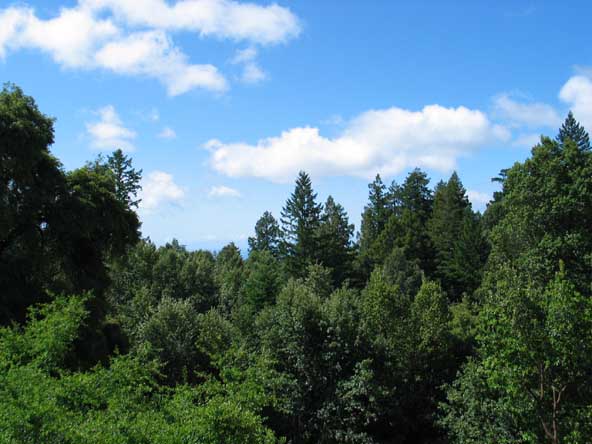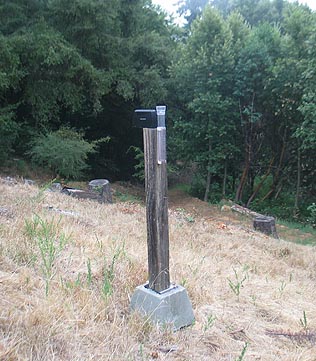Recent View looking South

05-27-06 at 10:30 AM
Clear cool and breezy
Measured at 2,200 feet AMSL, near the junction of Empire Grade and Pine Flat

| July 2005 | . |
. . |
. . |
. |
. |
. |
. |
. |
. |
. |
. | . | . | . | . |
Total: | |||||
|---|---|---|---|---|---|---|---|---|---|---|---|---|---|---|---|---|---|---|---|---|---|
| August 2005 | . |
. |
. |
. |
. |
. |
. |
. |
. |
. |
. |
. | . | . | . | . |
. |
Total: | |||
| September 2005 | . |
. |
. |
. |
. |
. |
. | . | . |
. |
. | 27th: .08" |
. |
. | . | . | Total: .08" | ||||
| October 2005 | . |
. |
. |
. |
. |
. | 15th: .04" |
18th: .04" |
19th: .08" |
. | 24th: .02" |
26th: .4" |
. . |
29th: .15" |
. |
Total: .73" | |||||
| November 2005 | . . |
4th: .5" |
8th: .7" |
9th: .1" |
10th: .04" |
. |
. |
. |
25th: .85" |
. . |
29th: 2.02" |
Total: 4.21" | |||||||||
| December 2005 | 1st: 4.5" |
. |
. |
. |
. . |
. . |
. . |
17th: 2.75" |
18th: 6.0" |
19th: 1.45" |
21st: 2.35" |
22nd: 3.4" |
25th: 2.2" |
26th: 1.05" |
28th 4.3" |
30th: 2.16" |
31st: 2.2" |
Total: 32.31" | |||
| January 2006 | 1st/2nd: 4.2" |
. . |
4th: .8" |
. . |
7th: .5 |
. |
. |
. |
11th: .2" |
13th: 1.75" |
14th: 1.25" |
15th: .05" |
17th: 1.1" |
18th: .1" |
21st: .2" |
. |
26th: .5" |
29th: 1.9" |
31st: .5" |
Total: 13.05" | |
| February 2006 | 2nd: .6" |
3rd: Trace |
4th: .25" |
. |
. |
. |
. . |
. . |
. . |
17th: .25" (snow) |
18th: .25" (snow) |
19th: .2" |
. |
. . |
26th: 1.3" |
27th: 1.6" |
28th: 1.25" |
Total: 5.7" | |||
| March 2006 | 2nd: .5" |
3rd: 1" (rain/snow) |
4th: .25" |
6th: 3.8" |
7th: .5" |
9th: .25" |
10th: .5" (snow) |
11th .3" (snow) |
12th: .75" (snow) |
14th: 1.9" |
15th: .2" |
16th: .44" |
17th: .32" |
20th: 1.52" |
21st: .47" |
25th: 4.6" |
28th: 1.6" |
29th: 1.4 |
30th: .25" |
31st: 1.5" |
Total: 22.05" |
| April 2006 | 2nd: 2.0" |
3rd: 1.8" |
4th: 1.9" |
5th: .6" |
7th: .6" |
10th: .2" |
11th: 3.6" |
12th: 1.7" |
14th: .25" |
15th: .35 |
16th: 1.3" |
. . |
. . |
. . |
24th Drizzle |
. |
. |
. |
. |
Total: 14.3" | |
| May 2006 | . . |
. |
. . |
. |
. . |
. . |
. |
. . |
. . |
. . |
. |
21st: .35" |
22nd: .5" |
. |
. |
. |
. |
Total: .85" | |||
| June 2006 | . |
. . |
. |
. |
. . |
. . |
. |
. |
. |
. |
. |
. |
. |
. |
. |
Total: | |||||
| Seasonal Total | 93.34 Inches | ||||||||||||||||||||
Just for comparison, you can look at a table of rainfall totals for a few previous seasons:
September into October was dry and warm, except for a brief cold snap at the end of September, and a brief tropical storm before that brought cloudy skies and brief thunder and lightning, and just a trace of rain. Early October brought fairly calm, clear warm days, and cool nights. And the first Alaskan pulse came through in the early morning of the 15th, leaving a trace of moisture, which appears to announce the beginning of the rainy season. Fog and drizzle, along with much cooler temperatures arrived on the 18th, with a slight trace of rainfall. After an overnight shower on the night of the 28th, a slight warming trend set in around Halloween.
November began cool and pleasant, but quickly turned cold and damp. And the first significant rain arrived the night of the 3rd. Indian summer arrived around the 12th and continued on into the week of the 21st, with record high temperatures and clear skies. Cool temperatures and rain finally returned again on the 25th. The end of November was wet and cold. The first of December was cold and very wet. This was followed by dry and fairly mild conditions. A very powerful storm with very gusty winds came ashore on the 17th, bringing over 5 inches of rain in less than 24 hours. Continued showers in the next week added to the totals. The 24th was warm and clear, but was quickly followed by soggy conditions on Christmas day. A major storm arrived on the 28th, followed by another more powerful storm on the 30th. The New Year was partly cloudy but cold up on Ben Lomond Mountain. The first days of the year brought heavy rain and cold temperatures. It was fairly pleasant but cool until another Pacific storm brought more rain on the 13th. And a brief group of showers passed by overnight on the 25th.
February began damp and cool, but then turned summer-like, with warm, sunny days and warm nights. On the 14th the temperature dropped 30 degrees (in six hours), and this was followed on the 17th by light snow and frigid temperatures.The 18th brought more snow and below freezing temperatures. Clearing skies and warming was evident on the 19th. Another strong Pacific storm arrived on the 26th and into the 27th, with heavy winds and moderate rainfall. More rain and cold temperatures came ashore on the 2nd of March. Light snow mixed with sleet fell on the 3rd. A very wet storm arived on March 5, bringing over 3 inches of rain overnight. Snowy weather returned on the 10th , with about 3" of the white stuff and temperatures in the upper 20's all day. 4 more inches of snow fell on the 12th. More cold rain fell on the 14th. Rainy days continued through March, with a very big downpour on the 25th. Temperatures remained well below normal. More heavy rain arrived on April 2nd and continued through the first week of April. A nice break in the rain arrived on the 7th, but cold wet conditions returned on the 10th. Another brief break on the 13th was followed by continued gloominess and rain. Spring appeared to be approaching during the later part of the last week of April. A summer pattern (fog at the beach, clear in the mountains) began as soon as the rain stopped. This was soon broken when a low pressure zone moved across the district and dropped nearly an inch of rain late in May, with colder air following for the next week. May 27th was cold, with lows in the 30's up on the mountain.

I keep these unofficial readings as a personal interest. I have seen our reading exceed other gauges that are located at lower elevations nearby, so I figured this might be of interest to others. For rainfall amounts up to 5 inches, I use a retail rain gauge. When amounts overnight are higher than 5 inches, I use, as a backup, a simple vertical wall bucket capable of holding up to 14 inches. I have to use the bucket at least a few times every winter. In years past, I was distrustful about the unusually high rainfall readings, changing gauges and trying various methods and locations to improve accuracy. However, after much experimentation, and then checking with our neighbors, I think we are simply in a micro-climate with more rain than other places. This is the Santa Cruz Mountains, after all. As the Weather Service says, we are in an "Orographically Favored Location." I think that means we get soggy when others simply get wet.
During the 2005-2006 season, I added an electronic gauge. It sits next to the "analog" gauge. So far, it tracks very close to the old fashioned method of walking out in the rain and checking throughout the day and night. The electronic gauge reads hundredths better than the old gauge, so it is useful for that at least. I use both of them at the moment, and will likely use them both for the foreseeable future. You never know when the batteries might fail, after all.
There is one official California Department of Water Resources weather monitoring site located nearby, at a slightly higher elevation. They match my readings here at 2200' fairly well. You can compare for yourself, at Ben Lomond Mountain (2630', three miles up the road from here). Their measured rainfall tends to be slightly less, but the temperature tracks pretty close to our location.
There are also a couple of other nearby, lower elevation locations where rainfall is measured. One long-time measurement created by Ted Cantrall is here, and another very informative site, run by the folks at Anometal.com can be found here.
As with most places in this region, we are in a "micro-climate". Ours happens to be very wet during the rainy season, due to our location, elevation and southern exposure to incoming storms. During large storms, average winds of 40 to 60 mph are typical here. In December of 1995, we had winds approaching 100 mph, and during February, 1998, peak winds approached 85 mph. The season is officially measured from July 1 to June 30, although rain usually only falls between September and May, a typical "dry and wet" seasonal pattern. Snow does fall here, but it is usually not more than a few inches at a time. The temperature range is not too extreme, and only falls below 25 degrees a few weeks every winter. 1991 was the exception, with lows in the teens for over a week. The winters of 1973, 1975, 1982, 1986, 1995, 1998, 2001, 2002 and 2006 brought significant snowfall.
If you found your way to this page via a search engine, please refresh or reload the page for the latest updates.
You can return to the Home page here.